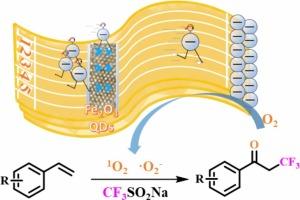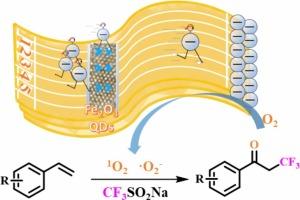Fe2O3量子点/2D g-C3N4复合材料在烯烃非均相光催化氧化三氟甲基化中的应用
IF 6.5
1区 化学
Q2 CHEMISTRY, PHYSICAL
引用次数: 0
摘要
在非均相催化体系中,研究α-三氟甲基化酮类化合物与CF3SO2Na的烯烃氧化三氟甲基化反应是一个很有前途的选择。然而,随着活性氧(ROS)的产生而发生的单电子转移(SET)过程,在非均相光催化领域很少报道。在这项研究中,我们报道了用煅烧法构建Fe2O3量子点(QDs)/石墨氮化碳(g-C3N4)层状纳米片的复合材料,用于光催化过程。令人兴奋的是,Fe2O3 QDs/g-C3N4-1200催化剂在温和条件下表现出最高的活性和广泛的底物柔韧性。此外,我们发现Fe2O3量子点可以提供有效的电荷分离,促进ROS的产生,这有利于CF3SO2Na对CF3自由基的活化。同时,充分暴露的金属活性位点已被证明是必不可少的。本研究为设计非均相量子点光催化剂提供了一种生态友好的方法,促进了氟化学的发展。本文章由计算机程序翻译,如有差异,请以英文原文为准。


Composites of Fe2O3 quantum dots/2D g-C3N4 for heterogeneous photocatalytic oxidative trifluoromethylation of alkenes
It is a promising choice to explore the oxidative trifluoromethylation of alkenes for α-trifluoromethylated ketone compounds with CF3SO2Na in heterogeneous catalytic systems. However, the single electron transfer (SET) process that occurred with production of reactive oxygen species (ROS), is rarely reported in the field of heterogeneous photocatalysis. In this study, we report composites of Fe2O3 quantum dots (QDs)/graphitic carbon nitride (g-C3N4) layered nanosheets constructed by calcination method for the photocatalytic process. Excitingly, the Fe2O3 QDs/g-C3N4-1200 catalyst exhibits highest activity and broad substrate flexibility under mild conditions. Moreover, we reveal that Fe2O3 QDs could offer efficient charge separation to facilitate the production of ROS, which is beneficial to activation of CF3SO2Na for CF3 radical. Meanwhile, sufficiently exposed metal active sites have been proven indispensable. This study provides an eco-friendly approach to design heterogeneous QDs photocatalysts, promoting the advancement of fluorine chemistry.
求助全文
通过发布文献求助,成功后即可免费获取论文全文。
去求助
来源期刊

Journal of Catalysis
工程技术-工程:化工
CiteScore
12.30
自引率
5.50%
发文量
447
审稿时长
31 days
期刊介绍:
The Journal of Catalysis publishes scholarly articles on both heterogeneous and homogeneous catalysis, covering a wide range of chemical transformations. These include various types of catalysis, such as those mediated by photons, plasmons, and electrons. The focus of the studies is to understand the relationship between catalytic function and the underlying chemical properties of surfaces and metal complexes.
The articles in the journal offer innovative concepts and explore the synthesis and kinetics of inorganic solids and homogeneous complexes. Furthermore, they discuss spectroscopic techniques for characterizing catalysts, investigate the interaction of probes and reacting species with catalysts, and employ theoretical methods.
The research presented in the journal should have direct relevance to the field of catalytic processes, addressing either fundamental aspects or applications of catalysis.
 求助内容:
求助内容: 应助结果提醒方式:
应助结果提醒方式:


